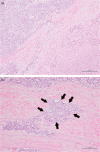A case of adenocarcinoma of the rete testis with durable response to cisplatin-based chemotherapy
- PMID: 34497979
- PMCID: PMC8413206
- DOI: 10.1002/iju5.12298
A case of adenocarcinoma of the rete testis with durable response to cisplatin-based chemotherapy
Abstract
Introduction: Adenocarcinoma of the rete testis is a rare malignancy with a poor prognosis. We report a case of adenocarcinoma of the rete testis with a durable response to cisplatin-based chemotherapy.
Case presentation: A 48-year-old man with Down syndrome (trisomy 21) presented with a 1-month history of painless swelling of the left scrotum. The physical examination revealed a left testis with a hydrocele associated with a tumor and enlarged pelvic and para-aortic lymph nodes. He underwent a radical orchiectomy. The specimen was diagnosed as adenocarcinoma of the rete testis. The patient received 7 cycles of chemotherapy (1 cycle of BEP and 6 cycles of EP) postoperatively. The metastatic lymph nodes were reduced in size for at least 12 months. Our patient with adenocarcinoma of the rete testis obtained an acceptable response to cisplatin-based chemotherapy.
Conclusion: We treated a patient with an adenocarcinoma of the rete testis who had an acceptable response to platinum-based chemotherapy.
Keywords: adenocarcinoma of the rete testis; cisplatin‐based chemotherapy.
© 2021 The Authors. IJU Case Reports published by John Wiley & Sons Australia, Ltd on behalf of the Japanese Urological Association.
Conflict of interest statement
The authors declare no conflict of interest.
Figures




References
-
- National Comprehensive Cancer Network . Plymouth meeting PA. NCCN Guidelines Version 1.2019 Testicular Cancer.
-
- Newbold RR, Bullock BC, McLachlan JA. Lesions of the rete testis in mice exposed prenatally to diethylstilbestrol. Cancer Res. 1985; 45: 5145–50. https://pubmed.ncbi.nlm.nih.gov/4027990/ - PubMed
-
- Polanco C, Pantazis CG, Prieto R. Papillary adenocarcinoma of the rete testis with adjacent hyperplasia: a case report. Case Rep Clin Pathol. 2015;2: 2:41–46. 10.5430/crcp.v2n2p41 - DOI
Publication types
LinkOut - more resources
Full Text Sources
